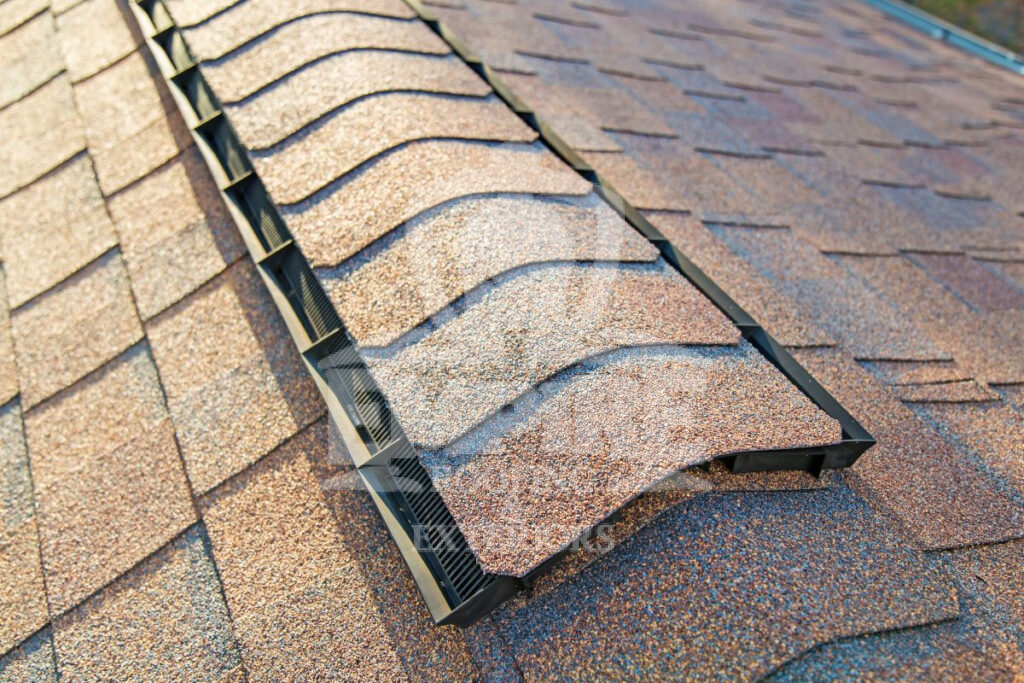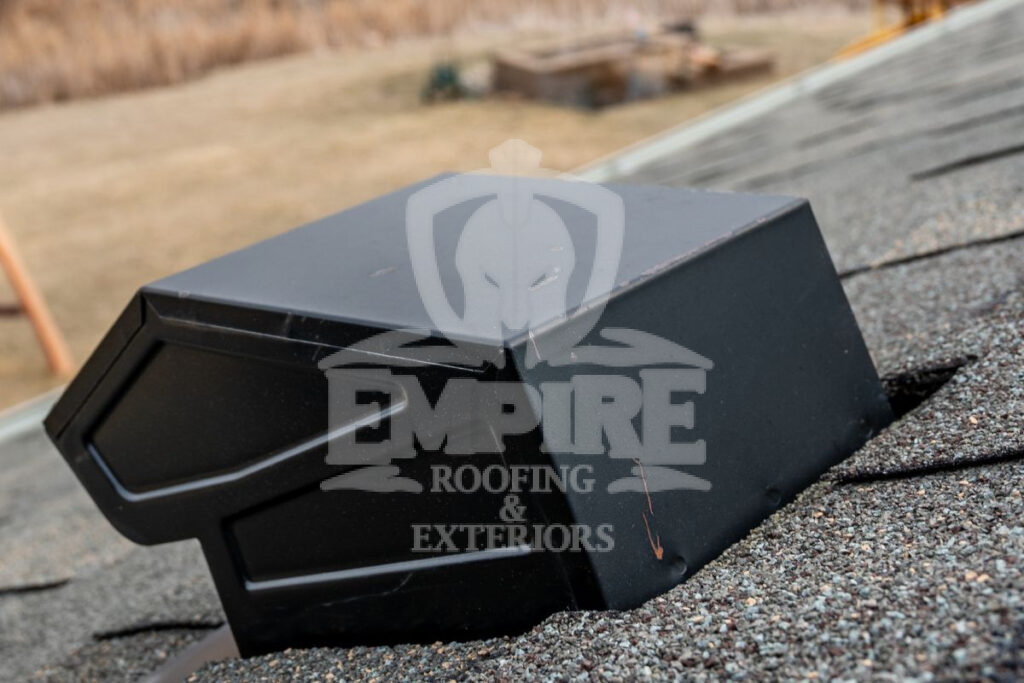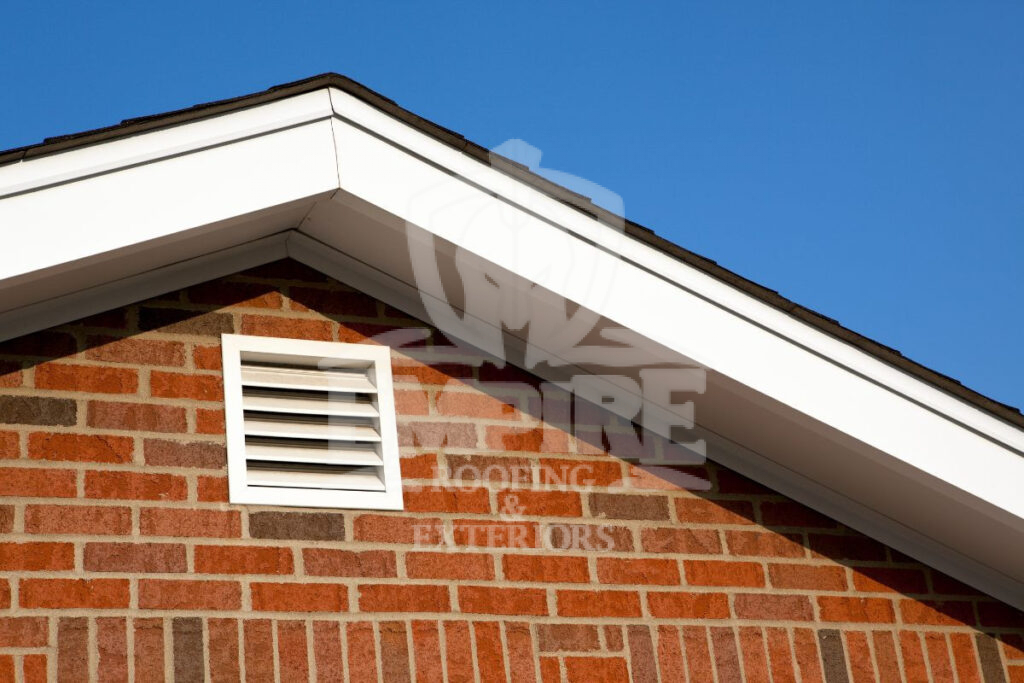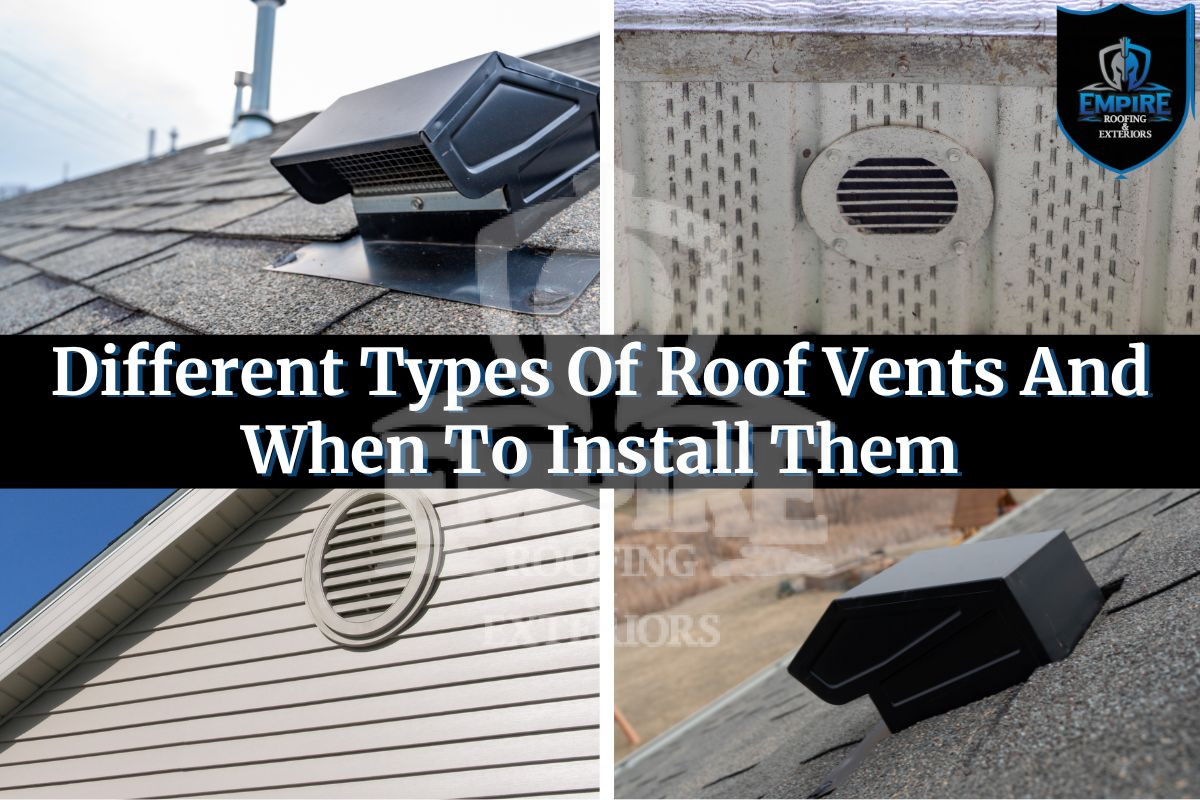Your home’s roof is more than just a protective covering, it’s an essential part of maintaining a comfortable and healthy interior climate. Appropriate roof ventilation is a frequently neglected component of roof maintenance despite being crucial for interior temperature control, avoiding moisture accumulation, and prolonging the life of your roof.
In this blog post, we’ll go through the various types of roof vents and explain the benefits and the best way to use them.
What Are The Different Types Of Roof Vents?
Any building or structure needs roof vents because they provide solutions for adequate ventilation and air quality. Here are some of the best types of roof vents you can go choose from as a homeowner:
#1. Ridge Vents

Ridge vents are vital for effective attic ventilation in a roofing system. They’re installed along the peak of the roof, and work based on the natural flow of air. Made of materials like aluminum or mesh, they’re typically positioned beneath ridge cap shingles to facilitate airflow. By expelling hot, moist air from the attic while drawing in fresh air through soffit vents, ridge vents help regulate interior temperatures for a more comfortable living environment.
Pros
- Enhanced Airflow: Works with intake vents for better attic ventilation
- Aesthetically Appealing: Sleek design blends well with the roof
- Proper Ventilation: Balances indoor temperature, reducing heat and moisture issues
- Longer Roof Lifespan: Allows heat to escape, extending the roofing materials’ durability
- Pest Barrier: Keeps out rodents, bees, and wasps from the attic
Cons
- Installation Cost: Initial expense is higher, but offers long-term benefits
- Water Leak Risk: Proper installation and maintenance are needed to prevent leaks
- Roof Shape Limits: Best suited for specific roof shapes like gable roofs
#2. Box Vents

The next type of attic ventilation system, box vents, also referred to as louver vents, feature square or rectangular openings capped at the roof to facilitate natural airflow for regulating attic temperature and moisture. They offer effective passive ventilation, renowned for their simplicity, affordability, and durability. While straightforward to install and compatible with various types of roofing systems, they aren’t as visually appealing as ridge vents, cover limited areas, and may not ensure continuous airflow. Typically, multiple box vents will be utilized to enhance attic ventilation, though their performance may be limited in regions with less wind.
Pros
- Easy Installation: DIY-friendly, so homeowners are able to install them themselves
- Roof Compatibility: Suitable for diverse roof types, offering flexibility
- Effective Ventilation: Efficiently ventilate attic spaces
Cons
- Aesthetic Concerns: Less visually appealing than ridge vents, and somewhat noticeable
- Coverage Limitation: Only cover specific areas, larger roofs may need multiple vents
- Reduced Airflow: May not ensure continuous airflow like ridge vents
#3. Soffit Vents

Soffit vents, essential components of a home’s ventilation system, are typically installed beneath the eaves of the roof and play a crucial role in improving attic air circulation, preventing moisture-related issues, and enhancing energy efficiency. Strategically positioned under the roof’s soffit, they allow fresh air to enter and circulate throughout the home, ensuring balanced temperature and humidity levels within the home. By initiating ventilation at the lowest point, soffit vents optimize attic airflow, promoting efficient air exchange and preserving the roof’s health and the overall integrity of the home.
Pros
- Better Air Circulation: Facilitates fresh airflow, preventing moisture buildup
- Moisture Prevention: Reduces mold and moisture-related damage
- Energy Efficiency: Lowers heating and cooling costs
- Enhanced Longevity: Preserves the roof’s structure
Cons
- Maintenance: Requires regular cleaning to prevent blockages
- Installation Complexity: Labor-intensive and needs careful planning
- Potential Blockages: Debris accumulation can hinder airflow
#4. Gable Vents

Installed on the gable ends of the roof, these vents simplify cross-ventilation by permitting airflow in and out of the attic. These vents, which are usually located close to the gable peak and are rectangular or triangular, help control attic temperature by allowing warm air to escape during hot weather. This reduces the workload on your home’s cooling systems and prevents moisture buildup, stopping mold growth and wood rot. Gable vents improve attic ventilation, but they might not be the best for complicated roofs with lots of peaks since they may interfere with other vents’ natural airflow, reducing comfort and increasing energy use.
Pros
- Aesthetic Appeal: Enhances the home’s exterior appearance
- Effective Ventilation: Facilitates attic airflow for cooling and moisture prevention
- Cost-Effective: Generally cheaper and easier to install compared to other types of vents
Cons
- Potential for Leaks: Improper installation can lead to leaks in heavy rain or snow
- Visibility: Visible on the exterior, which may not suit all architectural styles
#5. Over-Fascia Vents
Underneath the shingles, on top of the fascia board, over-fascia vents can be installed to allow air intake when the wind hits a shingled roof. They provide a more modern method of roof ventilation by allowing air to enter through holes along their edges and are advised for use on homes without soffit vents, and for complex roofs where soffit vents alone would not be adequate.
Pros
- Effective Ventilation: Maintains attic temperature by drawing in cooler air from outside
- Aesthetically Pleasing: Visually appealing compared to other options
- Prevents Moisture Issues: Reduces the risk of mold and rot in the attic
Cons
- Excessive Airflow: May cause noise and a wind tunnel effect
- Debris Accumulation: Increased risk of debris entering the attic
- Installation Challenges: Correct installation is crucial to prevent moisture infiltration and airflow obstruction
#6. Roof Turbines (Wind Powered)

By utilizing wind power, turbine vents, commonly referred to as whirlybird vents, provide an inventive attic ventilation solution. Warm air is drawn out of the attic by the rotating metal or plastic heads on the vents, which produces a partial vacuum effect. Turbine vents are silent and energy-efficient because they only use the natural flow of air, which saves money and the environment. However, it takes wind going at 5 to 6 miles per hour to activate these vents, meaning that larger attics or areas with little wind may require more than one type of vent in their home to ensure adequate ventilation needs are met.
Pros
- Efficient Air Circulation: Draws out hot air to prevent heat and moisture issues
- Energy Efficiency: Lowers attic temperature without electricity, reducing energy bills
- Low Operating Costs: Maintenance-free operation saves on monthly expenses
- Durability: Made from sturdy materials to withstand weather conditions
Cons
- Susceptible to Clogging: Debris or rain may block slits, affecting performance
- Visibility: More noticeable on roofs, some may find them unattractive
- Exposed Moving Parts: Maintenance may be needed for damaged parts, potentially causing noise
When Is The Right Time To Install Roof Vents?
Installing roof vents is essential for maintaining a healthy and efficient home environment. Here’s when to consider installing roof vents:
1. During New Roof Construction:
The ideal time to install roof vents is during new roof construction. This ensures seamless integration and prevents issues like moisture buildup and heat retention from the start.
2. When You Notice Roof Ventilation Issues:
If you notice signs of poor ventilation, such as moisture buildup or mold growth, it’s time to install roof vents to prevent further damage.
3. During Roof Repairs or Replacements:
When undertaking roof repairs or replacements, consider installing or upgrading roof vents to enhance performance and extend the lifespan of the roof.
4. Before Periods of Extreme Weather:
Installing roof vents before seasons of extreme weather can regulate temperature extremes and prevent issues like excessive heat buildup.
5. When Planning a Loft Conversion:
Installing roof vents is essential when planning a loft conversion to ensure adequate airflow, comfort, and indoor air quality.
Also read: 9 COMMON ROOF VENT PROBLEMS & SOLUTIONS EVERY HOMEOWNER SHOULD KNOW ABOUT
Ensure Your Roof Is Properly Ventilated In Baton Rouge With Empire Roofing & Exteriors
A healthy home depends on adequate ventilation, and roof vents are an important part of that. By knowing the different types of roof vents that are available and the pros and cons of each, you can control attic airflow and increase the lifespan of your roof. Empire Roofing & Exteriors offers professional roofing services that are customized to meet your needs. Our roofers maintain the best possible ventilation while guaranteeing the longevity of your roof. Choose Empire Roofing & Exteriors, Baton Rouge’s top residential roofing contractor, for quality roofing solutions. Call (225) 347-8877 to speak with one of our experts today.
